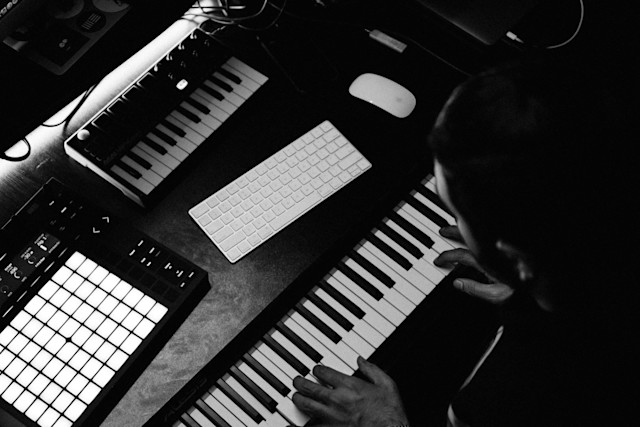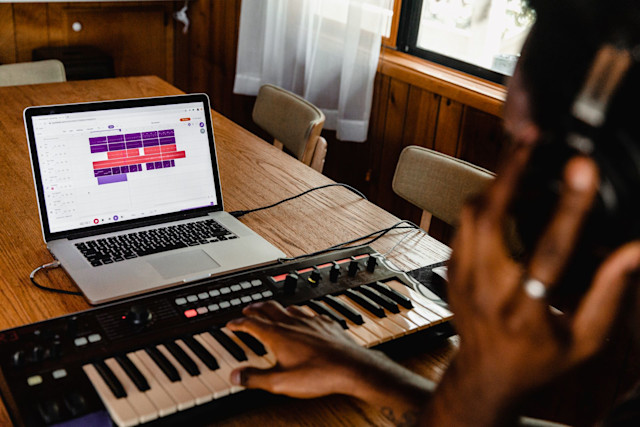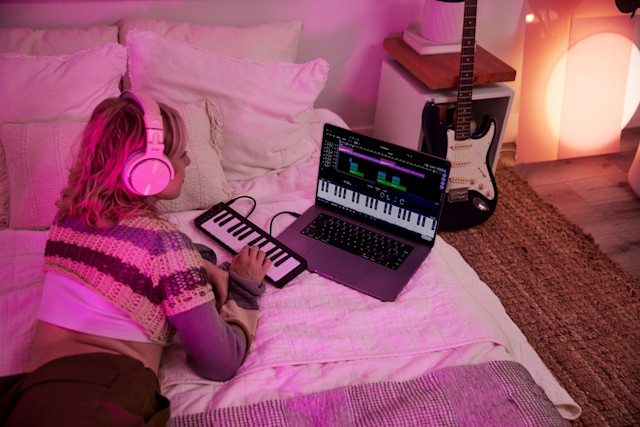What is a MIDI keyboard and how is it used in music production
November 25, 2024 - Discover how MIDI keyboards transform music creation and learn how to make the most of this essential tool in modern production.

Music is a universal language, but behind every melody there are tools that help turn ideas into sound reality. One of the essential devices for modern producers is the MIDI keyboard. This controller has redefined how music is created, performed and produced in the digital environment.
Whether you're a beginner exploring your first chords or an intermediate producer looking to expand your creative arsenal, understanding the role and possibilities of the MIDI keyboard is crucial.
In this article, we'll explore what a MIDI keyboard is, how it works, its main applications in music production, popular types, and some practical tips for using it creatively and efficiently.
MIDI history at a glance
MIDI, or Musical Instrument Digital Interface, is a communication standard that changed music production forever. It was born in the 1980s with the purpose of solving a crucial problem: connecting and synchronizing electronic musical instruments from different manufacturers. Before MIDI, each brand used its own standards, which made it difficult to integrate equipment.
In 1981, Dave Smith and other visionaries proposed this universal protocol, and in 1983 it was officially introduced to the world with the Sequential Circuits Prophet-600 synthesizer as the first MIDI instrument. Since then, MIDI has been central to modern music creation, enabling not only interoperability between equipment, but also the development of DAWs and digital tools.
What is a MIDI keyboard?
A MIDI keyboard is a device that allows musicians and producers to send MIDI data to other equipment, such as computers, synthesizers, sound modules or digital audio workstations (DAWs). Although it has keys similar to a piano, a MIDI keyboard does not produce sounds on its own. Instead, it acts as a controller that sends information, such as which note was played, how loudly and for how long, as well as other functions that we will see later.
Basic concepts:
Notes and velocity: MIDI keyboards send data of the note played and the force with which it is pressed (velocity), which affects dynamics and expression, giving you the human touch that would be more difficult to achieve by typing notes directly into the piano roll.
Aftertouch: Some models allow you to manipulate effects such as vibrato or filters by pressing harder on a key after playing it.
Not just keys: Most MIDI keyboards include pads, knobs and faders that control effects or mixes within a DAW. This opens up a world of possibilities, making your creative process more efficient and giving you new tools to experiment with in your productions.

How is a MIDI keyboard used in music production?
MIDI keyboards are a versatile tool that encompasses almost every aspect of the creative process. Here are some of their most common applications:
1. Composition
MIDI keyboards are ideal for creating melodies, harmonies and chord progressions. Connected to a DAW, they allow you to use virtual instruments (VSTs) that simulate everything from pianos and synthesizers to strings or exotic sounds.
Practical tip: Use functions such as “scale modes” (available on models like the Novation Launchkey) to limit notes to a specific key and avoid mistakes in your composition. This will be a great help if you have not yet mastered music theory, helping you to focus on the idea you are developing.
2. MIDI recording and editing
MIDI not only records the notes you play, but also allows you to edit them later. You can adjust the duration, intensity, tempo or even change the assigned virtual instrument.
This works very well especially on drums and also on guitars and keyboards, a clip programmed directly on the piano roll will not sound with the same groove as it would if you record it yourself with a MIDI controller, it is natural that some notes are a bit off the grid, however that feeling will make your beats sound more natural and less robotic.
Practical tip: Use Quantize to align your notes to the tempo of the project, but don't overuse this feature if you don't want to lose the human touch that you are giving to your recordings by being the one who is performing.
Some DAWs allow you to set the quantized percentage to be applied, this makes your recording closer to the grid without losing the groove or that imperfect, human touch that makes the music sound more natural.
3. Live performances
On stage, MIDI keyboards are one of the most important tools, allowing you to trigger loops, control effects, adjust dynamics and volumes, play virtual instruments in real time or even control lights and effects.
Models like the Akai MPK Mini are compact and portable, ideal for live performances. Also practice your setups live to avoid technical problems on stage.
Choosing the right MIDI controller
When shopping for a MIDI controller, it's crucial to consider your needs, production style, and budget. Some essential aspects you can keep in mind to make the best decision are:
1. Number of keys and size
Need mobility or more range?
Small 25- or 32-key controllers are ideal for producers who travel or have limited space. For pianists and arrangers looking to perform more complex pieces, one with 49, 61 or even 88 keys may be better.
Key type:
Mini keys: portable but less expressive.
Semi-weighted or counterweighted: Closer to the experience of a traditional piano.
2. Additional functions.
Pads and knobs:
If you work with percussion or effects, look for a controller with velocity-sensitive pads.
Knobs, sliders and buttons are useful for automating parameters such as volume, filters or effects.
Compatibility with DAWs:
Some controllers, such as those from Novation or Akai, have automatic integration with popular software such as Ableton Live, FL Studio or Logic Pro.
3. Connectivity
USB only or traditional MIDI connections?
If you have external hardware such as synthesizers or samplers, make sure the controller has standard MIDI outputs.
Power supply:
Some controllers need external power, while others are USB powered, which is more practical.
4. Budget and brand
Entry level: Arturia MiniLab, Akai MPK Mini.
Mid-range: Novation Launchkey, M-Audio Oxygen Pro.
High-end: Native Instruments Komplete Kontrol, Akai MPK249.
Opt for well-known brands, as they tend to offer better support and durability.
5. Tactile experience and expressiveness
If the “feel” of the keys is important, try it in a physical store before you buy. Aftertouch keys add an extra layer of expressiveness, allowing you to control effects by pressing harder.
6. Bundled software
Many controllers come with free software such as DAWs, virtual synthesizers or sound libraries. This can be an added value if you're just starting out.
Most popular MIDI controllers among producers
Experienced producers often choose MIDI controllers that complement their workflow. Some of the most famous include:
Akai MPK Mini: Compact, with sensitive drum pads and assignable knobs.
Novation Launchkey: Designed for Ableton Live, it includes RGB pads and creative arpeggiators.
Arturia KeyLab: Offers advanced DAW integration and a premium key feel.
Native Instruments Komplete Kontrol: Perfect for Komplete instrument users, with intuitive navigation functions.
Roli Seaboard: An innovative design that allows you to play with expressive techniques such as slides and vibrato.
Tips for using MIDI keyboards creatively
1. Record everything you play:
Use the MIDI keyboard to improvise melodies and chords directly in your DAW. Many times, spontaneous ideas are the most creative.
I imagine it has happened to you that you are looking for a melody, and when you find it and want to record it, you simply forget it. You can avoid this by recording everything you play when you are looking for ideas, then you can listen, edit and use what you need.
2. Use arpeggiators and auto-scales
Built-in arpeggiators transform chords into rhythmic patterns, ideal for genres like EDM or film. Set the keyboard to limit notes to a specific scale, facilitating harmonic experimentation.
3. Experiment with unconventional sounds
Assign percussive sounds or effects to the keys to create unique textures. For example, you can map foley sounds (footsteps, rain, etc.) to add ambient details to your tracks.
4. Manipulate effects in real time
Assign knobs and faders to parameters such as filters or reverb. During a recording, adjust these effects for more dynamic transitions, this will give a more natural touch to your automations.
5. Practice playing expressively
Key sensitivity (velocity) allows you to humanize your playing. Spend time learning how to vary the intensity of your notes for a more realistic touch.

Tips for optimizing your workflow with a MIDI keyboard
Practice regularly: Spend time practicing scales, progressions, and playing techniques. This streamlines your ability to capture ideas quickly.
Transport shortcuts: Use assignable buttons for play, stop, record and navigation.
Set up templates in your DAW: Define MIDI mappings and presets to avoid setting up each session from scratch.
Set up keyboard zones: Use the split function to assign different sounds to each section of the keyboard, such as a bass on the left and a pad on the right.
Maintenance: Clean your keyboard regularly and avoid constantly plugging and unplugging cables to prolong its lifetime.
The MIDI keyboard as a tool for creativity
Beyond its technical aspects, a MIDI keyboard is an infinite instrument with which you can express your ideas. Its versatility makes it an indispensable ally, whether to create a basic beat or a complex, multi-layered composition.
As a producer or composer, investing time in understanding and experimenting with your MIDI keyboard is one of the best decisions you can make. Every key, knob or pad is a doorway to a world of sound full of possibilities.
About the author
Odiseo is a music producer and mixing and mastering engineer with experience ranging from music creation as a session and concert musician, beatmaker, live sound engineer, and recording engineer, to audio production for short films, providing a broad perspective on technical concepts and musical skills to take music to another level.
Get started with Soundtrap today!